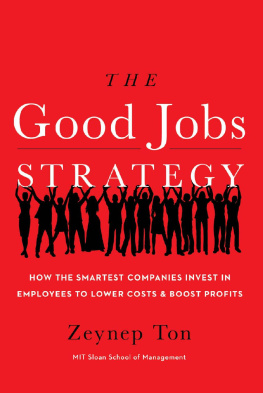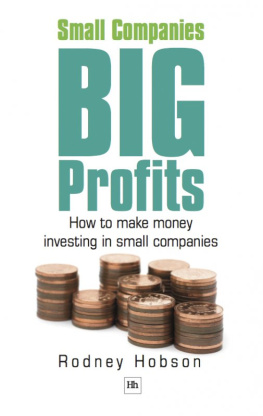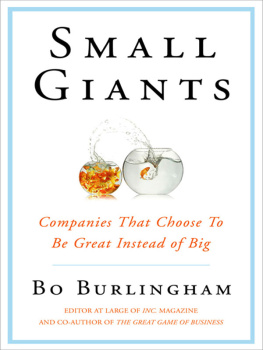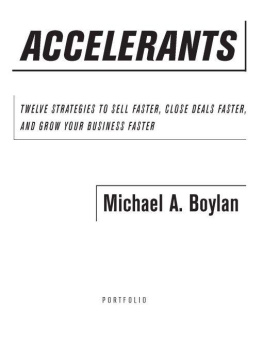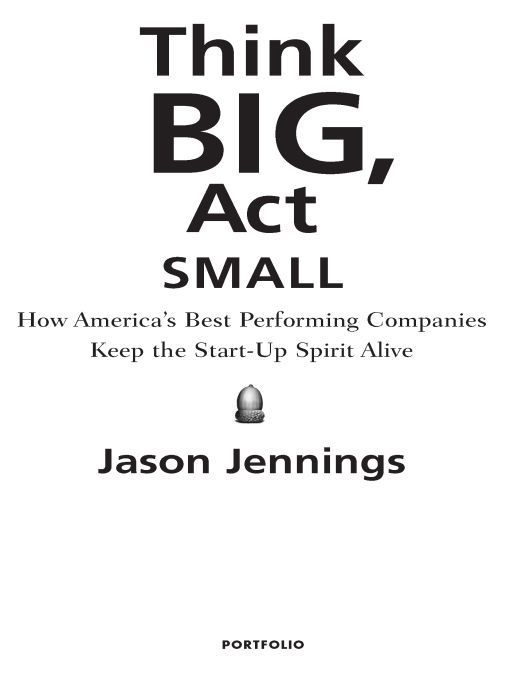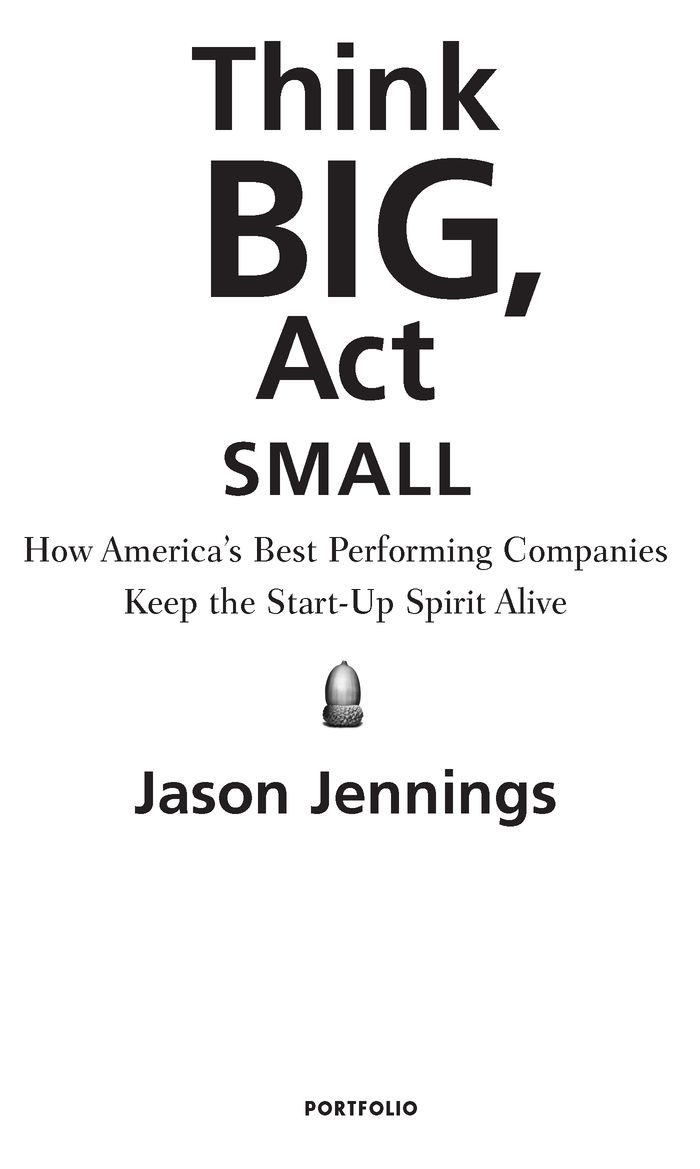Table of Contents
ALSO BY JASON JENNINGS
Less Is More
How Great Companies Use Productivity
as a Competitive Advantage
Its Not the Big That Eat the Small...
Its the Fast That Eat the Slow
with Laurence Haughton
PORTFOLIO
Published by the Penguin Group
Penguin Group (USA) Inc., 375 Hudson Street, New York, New York 10014, U.S.A.
Penguin Group (Canada), 10 Alcorn Avenue, Toronto, Ontario, Canada M4V 3B2
(a division of Pearson Penguin Canada Inc.)
Penguin Books Ltd, 80 Strand, London WC2R 0RL, England
Penguin Ireland, 25 St. Stephens Green, Dublin 2, Ireland
(a division of Penguin Books Ltd)
Penguin Books Australia Ltd, 250 Camberwell Road, Camberwell,
Victoria 3124, Australia (a division of Pearson Australia Group Pty Ltd)
Penguin Books India Pvt Ltd, 11 Community Centre, Panchsheel Park,
New Delhi - 110 017, India
Penguin Group (NZ), Cnr Airborne and Rosedale Roads, Albany,
Auckland 1310, New Zealand (a division of Pearson New Zealand Ltd)
Penguin Books (South Africa) (Pty) Ltd, 24 Sturdee Avenue,
Rosebank, Johannesburg 2196, South Africa
Penguin Books Ltd, Registered Offices: 80 Strand, London WC2R 0RL, England
First published in 2005 by Portfolio, a member of Penguin Group (USA) Inc.
Copyright Jason Jennings, 2005
All rights reserved
Publishers Note
eISBN : 978-1-101-11821-4
CIP data available
This book is printed on acid-free paper.

Without limiting the rights under copyright reserved above, no part of this publication may be reproduced, stored in or introduced into a retrieval system, or transmitted, in any form or by any means (electronic, mechanical, photocopying, recording or otherwise), without the prior written permission of both the copyright owner and the above publisher of this book.
The scanning, uploading, and distribution of this book via the Internet or via any other means without the permission of the publisher is illegal and punishable by law. Please purchase only authorized electronic editions and do not participate in or encourage electronic piracy of copyrightable materials. Your support of the authors rights is appreciated.
http://us.penguingroup.com
This book is dedicated to my mother and father,
Bill and Beverly Jennings,
for being great parents and wonderful friends.
INTRODUCTION
Youre about to learn the identities of a handful of companies whose consistent revenues and profit growth places them among the top one-hundredth of 1 percent of all American companies. Having increased revenues and profits by 10 percent or more for ten consecutive years, they routinely accomplish what the rest of us (the other 99.99 percent) have, as yet, only dreamed about. Heres why what these companies do is vitally important... to you.
Raising Revenues and Profits Isnt an Option
The bottom-line need of every business is constantly higher revenues and profits. Ambitious workers want to improve their lot in life and expect raises. Competitive spirits demand runs on the scoreboard. And investors and shareholders have insatiable appetites for constantly higher returns. Companies that arent going forward are going backward!
Executives and managers who fail to consistently increase revenues and profits end up with their heads on a stick, and business owners who dont grow revenues end up with empty storefronts, deserted factories, and haunting memories of what could have been. Historically, business managers and owners have had three choices for constantly improving the financial performance of their business.
Increase Revenues
Its easy to increase revenues when the economy is in terrific shape, the competition isnt paying attention, and people are knocking down your door to buy what you sell. Unfortunately, those days are over. Economies everywhere are fragile. Everyone has more and better competition than ever before (and that wont change) and nobody absolutely needs anybody; everyone has plenty of alternatives. Today business managers and owners are forced to constantly increase revenues in the most challenging environment that has ever existed. The problem is that the tactics used by most owners and managers to grow revenues are tired reruns of old conventional wisdom.
Haul the sales staff in here! bellows the boss. Ill give them the Come-to-Jesus routine and fire them up.
Regrettably, the result of rallying the troops is always short-lived.
Enter the recent MBA graduate, bursting with ideas. Maybe increasing sales commissions for brand-new businesses and lowering them for existing customers is the answer, he muses. In one case we studied during my semester abroad, a Mongolian company did that and increased their sales of yak jackets by twenty percent.
Unsurprisingly, changing incentives and playing with peoples paychecks and livelihoods seldom have a positive effect on morale.
I have an idea, pipes up an assistant brand manager. Lets add some jalapeo flavoring to our Super Crunchy Rice Flakes, call them Ol! Ol! Ol and have the sales staff introduce the product wearing sombreros!
Sorry to be the bearer of bad news, but 96 percent of brand extensions failand the failure rate is probably higher for last-gasp measures.
What we really need, laments the old-timer who has been around the block more times than a septuagenarian streetwalker, is to find some low-hanging fruit, some real easy business. Hoping against hope, he adds a wistful, Its got to be out there in some place weve never looked before.
Alas, competition is tougher than its ever been. What to do when all the low-hanging fruit has been picked?
Invariably, the same old tactics for increasing revenues bring the same old results. More often than not, companies end up failing to achieve their revenue growth objectives and so resort to quick fixes to demonstrate short-term profit growth.
Cut Costs
A second way to improve a companys financial performance is usually the most unpopular option for your employees: cut costs. Cut cut cut. Layoffs, shutdowns, contractions, and asset sales are employed in order to improve short-term profits. All of these moves, of course, come back to bite these companies on their backsides. Reducing, snipping, and nonstop rounds of cutting does nothing to jump-start or grow revenues. Downsizings and layoffs frequently become as addictive as street drugs, and the companies that abuse them end up emaciated shadows of their former selves.
Or, Cook the Books
When companies fail to increase their sales and find their bag of cost-cutting tricks empty, many resort to playing loose with the truth. Of the 1,200 publicly traded companies forced to restate their operating results for 2003 under the Sarbanes-Oxley Act, every single company had to adjust their revenues and/or profits downward. They had all claimed that their revenues or profits were higher than they actually were. Not a single company had understated revenues or profits.
What We Found
So what do you do if the three common ways of posting financial health are close to defunct? We went on a hunt for answers. My team of researchers and I evaluated and studied every publicly traded company (about twenty thousand of them) in the world as well as more than fifty thousand of the largest privately owned companies in the United States in order to find the companies that do the best job of consistently increasing revenues and profits. (Youll find a narrative describing our complete research methodology in Section 5.) We reasoned quite simply that if we could identify the companies that do the worlds best job of consistently increasing revenues and profits, thered be valuable lessons to learn. So we traveled the nation; got inside every company wed identified; and interviewed, studied, observed in action, and got to know the people who lead Americas best performing companies. We were hardly disappointed.



